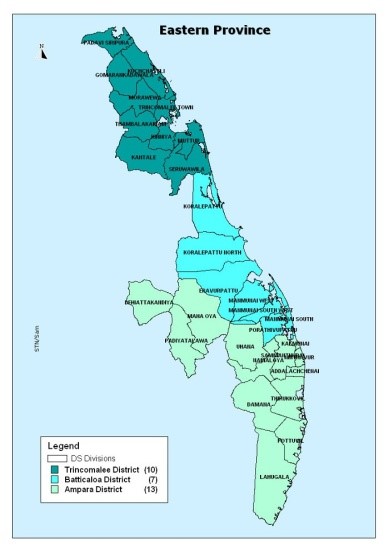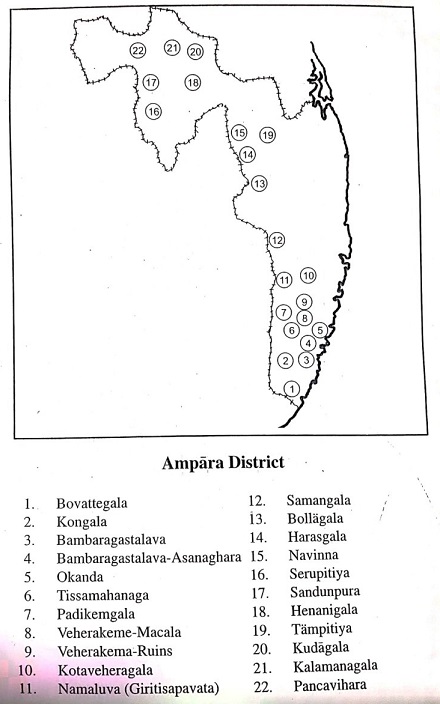BUDDHIST CIVILIZATION IN THE NORTH AND EAST OF ANCIENT SRI LANKA Part 1
Posted on July 28th, 2020
KAMALIKA PIERIS
This essay is on the findings of Ven Ellawala Medhananda.Ven. Ellawala Medhananda paid special attention to the Buddhist archaeological remains in the North and east. He explored as much as he could in these two provinces, using his own resources He found that the north and east had many Buddhist ruins and many explorations were needed, before they could be fully examined and recorded.
If one travels north along the sea coast road, starting from Trincomalee town, one can see many Buddhist ruins, even at present, he observed. Many ruins can be seen at Ridikanda area in Trincomalee district as well. In Batticaloa district, in the deep forest, there is Vasibandagala, Atubandagala, Iddagala, Nelugala, and Mavulivala, full of ruins which have not been explored.
Medhananda found that the public did not know that there had been a vibrant Buddhist civilization in the north and east. Nobody had gone and researched there. So, for several years, after each exploration, Medhananda wrote up his findings and sent them ‘Divaina’ newspaper. These writings were very popular. Thousands of readers have encouraged me by letter and phone calls, after reading what I wrote, said Medhananda. Medhananda made particular mention of Prof Wijaya Dissanayake, then in London.
Medhananda was repeatedly asked to put his writings into one book. The result was, Pacina passsa, uttara passa, nagenahira palata ha uturu palate Sinhala Bauddha Urumaya” (Dayawansa Jayakody, 2003). The book has gone into five reprints, the last was in 2013. It is a substantial text of 536 pages, giving detailed descriptions of the ruined Buddhist viharas and monasteries. This book has been translated into English as ‘The Sinhala Buddhist heritage in the east and north of Sri Lanka (Dayawansa Jayakody, 2005) .This is not a very good translation and has many omissions. I would therefore advise readers to go direct to the Sinhala original.
Medhananda has prepared a set of maps which showed the Buddhist ruins found by him, which are NOT shown on the map compiled by the Department of Archaeology. The maps therefore only show the places Medhananda has found, they do not show all the Buddhist ruins found in the Province. This should be kept in mind.
Medhananda‘s maps shows 17 new locations for Jaffna, including 4 on the smaller islands and 19 for Vavuniya and Mullaitivu Mannar has 32 places, of which 15 are lined along the sea coast. The map of the Eastern province showed Ampara 22 places, many along the coast or near it, Trincomalee 6, and Batticaloa 4. These maps are found in the English translation, not in the Sinhala original. Medhananda says this list is incomplete. ‘There should be much more than we found.’

Medhananda was able to explore the Eastern Province with greater freedom than the north. Medhananda has explored 80 Buddhist sites In the Eastern province. They included Agbo Raja Maha Vihara, Ariyakara Raja Maha Vihara, Bollegama Raja Maha Vihara, Balahandu vihara, Bambaragastalawa vihara, Boralukanda temple, Nilaveli. Bowattegala vihara, Buddhangala hermitage, Dighavapi, Diviyagala vihara , Ganegama vihara , Girikumbara vihara , Habutala Karandahela vihara , Harasgala vihara , Henanegala cave temple, Illukpitiya kanda len vihara Ampara. Kalkulam Udagala Dagoba, Kiliveddi bodiya, Kirivehera Raja Maha Vihara, Kombanachhi Ruhunu Somawathi vihara , Kongala natabun vihara , Kopavela vihara , Kotaveheragala vihara , Kuchchaveli Maha vihara, Kudimbigala hermitage, Kukuluvagala vihara, Lankapatuna Samudragiri vihara , Linemalai Sipavata vihara , Malayadikanda vihara, Namalu vihara , Nawinna Raja Maha Vihara ( Ampara), Neelagiri vihara and cave, Niyaguna kanda vihara , Okanda vihara , Omunugala cave temple, Panama raja maha vihara , Piyangala vihara , Pulakunava Maha vihara , Rajagala Maha vihara , Ratgala vihara , Rugama Piyakalutota vihara, Ruhunu magul maha vihara , Samangala hermitage, ,Samudragiri, Sastravela vihara , Seruwila vihara , Sri Pana Raja Maha Vihara, Potuvil, Tilapola pansala, Tiriyaya, Udayagiri Raja Maha Vihara , Vedikkinarmalai rock temple, Veheragala cave temple, Veheragama kubira therun vanaya Ampara, Veherakema Mavala vihara , Velatti badda aramaya and Velgam vihara.
Medhananda has also looked at ruins. These are generally of monasteries or vihara, but some were settlements. Medhananda found ruinsat Ananda kulam , Agbo Raja Maha Vihara , Allai, Arantawala Balagala, Bandaraduva ,Buriyakulam kanda , Dighavapi, Etha bandi wewa, Galkanda , Hingurana sugar factory (ruins near it). Ichchalanpattai, Kadolupotana kanda Kandikudichchi aru, Kondavattavana, Koravanvadu, Kantalai track 6 and track 13 ruins, Kivulevatta , Kulankullimalai , Kunchinamalai, Mulgama kanda. Moraha Pokuna, Mundikulam malai Narakamulla, Nuwaralagala, Padi kemgala, Pallewela, Paragahakele, Pulmoddai , Punyadi , Ridikanda Ranankaduwa, Sembumalai Serupitiya, Seruwila, Sunetra wewa, Taravakulam, Tirumangala, Toppigala , Valmandiyagala Veheragala, Veheragoda , Veherakema, Veheratenna, and Vilankulam.
Medhananda has also looked at ancient wewas in the Eastern Province. He found 115 ancient wewa in Ampara district, 64 in Batticaloa district and 300 in Trincomalee district. In Batticaloa and Trincomalee most of the wewa were known a ‘kulam’. Medhananda has also listed 66 ancient wewas mentioned in inscriptions.
Medhananda made it a point to record the ancient names of the places he explored. Mahakaccakodiya vihara in Vavuniya was Tittavalkada, . Kuchchaveli maha vihara was Samudradevi vihara. Verugal was originally Veheragala. Kottiyar pattu was Kotthasara. Panama was known as Vajana rata in 7th century. A Gama donated to an aramaya become ‘aramagam’ which became ‘Arugam’. Rugam is the Tamilisation of this, said Medhananda .
Medhananda commented on the ruins he saw. The Yan Oya valley is studded with many stupas and other buildings, he said. Inscriptions show that there were Buddhist settlements there. At Lankapatuna Medhananda Found an unprotected moonstone, the rest have been destroyed. I found 6 inscriptions there. After I told them the Department of Archaeology went and copied the inscriptions.
The most number of ruins were found at Ampara. One and a half miles to the east of the preset Devalahinda school, Ampara, there are many ruins of stupas, ponds, Buddha foot prints, and asanagharas. there is a wall fortification 7’ wide, stretching for a distance of about 600 feet.
Sembumale monastery complex spreads over an area of more than hundred acres. Somawathi vihara, Kombanachchiya had ruins no one has seen before. Places like Diviyagala, Damana and Timbirigolle in the vicinity also have inscriptions and ruins. Budu patum kande is ‘full of ruins’. Medhananda found a sandaka pahana there, also interesting bricks.
Veherakema, originally known as Mavala vehera is in the middle of the Lahugala forest. Medhananda took four hours to travel the 7 or 8 miles to get there. he was the first to explore Veherakema. He found a huge rock with the ruins of a probable padhanaghara, columns 6 or 7 feet high and a plain moonstone without decoration.
In the Veheragoda ruins at Ampara, there is a stupa which shows the earlier style of stupa building. this style is also seen at Buddhangala and Rajagala. Veheragoda wewa had a kalugal sorrowwa.
At Karandahela, Medhananda found a lotus petal moonstone, very old bricks, a huge cave, 512 feet long, 30 ft wide, and 82 feet height and a rock carved gal vangediya, one foot deep with circumference of 7’ 2”.
At Veheragalkanda, Medhananda saw a foundation , 50’ x50’ with stone door frame facing the east 9’8” in height There was another structure, 18’8’ by 14 ‘1” with ten pillars in the middle, this could be a gigantic doorway, said Medhananda . When I first visited the place there was a torso of a statue lying there but ‘now it is not to be seen’.
Bambaragastalawa has acres of ruins, many, many stupa on hill tops and flat ground, also remains of viharas, image houses, as well as steps, pillars and caves. There was no road access to Bambaragastalawa. Medhananda had to go through dense forest inhabited by wild animals.
Medhananda said that many of the places he saw have not been looked at by the Department of Archaeology. There are far more Buddhist ruins in Trincomalee district than the 54 given by the Department, Medhananda said. In our exploration at Digamadulla, too we found many inscription and ruins never seen before. The ruins around Dighavapi have not been explored, either.
Medhananda had explored Bambaragastalawa, Lenama, Budubava, Nalitta, and found ruins which the Department of Archaeology had not found. There are no reports in the Department of Archaeology as to the ruins at Mahapattuva , 8 km from Timbirigolla Vidyalaya. I found very fine archaeological ruins at Kadavat maduva near Batticaloa railway station. No one had looked there.

Toppigala has not been properly explored by the Department of Archaeology . Medhananda found 150 archaeological sites in Toppigala. All hillsides around Toppigala such as Motagala, Vesibandagala, Atubandagala, Varakamulla, Kunchinamalai, Devinigala, Kavinigala, had vihara on it. Every hill side around Thoppigala has a ruin of an aramaya. There were inscriptions too. I spend 8 days exploring in Toppigala jungles, said Medhananda .
Viharagal kanda at Trikonamadu has ruins extending for 10 acres. These have not been explored before. The ruins of stupa, walls, caves, asanaghara could be seen. There is an ancient wewa near ruins. The archaeological sites at Vasi bandagala, Atubandagala, Iddagala, Nelugala, Mavulivala, have not been explored before. There are lots of ruins . Siripalena, Siluminiseya, Devagala in Maduruoya valley also have unseen ruins.
The area north of Badulla –Eravur has not been explored. Lots of Buddhist sites there in the forests, also ruins of irrigation schemes. There are Buddhist ruins also at Perillaveli in Eravur pattu, Batticaloa district. These are in dense forest and have not been seen by the Department of archaeology.
Medhananda found that many areas, now thick forest, had been populated in ancient times. The whole Thottama area was populated. A part was at Digamadulla under Ruhuna, a part was under Wellassa. Irrigation channels at Valmandiyagala showed that this was a large settlement. Periyakulam is actually Manamatta wewa and is part of the Sinhala irrigation schemes. Kannimaduwa inscription refers to Salapavu vehera and its villages, said Medhananda .
Medhananda found 114 wewas at Dimbulagala as well as an area which had held paddy fields in the ancient period. . Harasgala and Serankada vihara near Maha oya were prosperous in ancient times said Medhananda. Veherapokuna in Maduru oya valley was an important stopping place between Magama and Jaffna. Ruins at Velatti badda aramaya in Uhana, shows that this was a very developed aramaya.
The north and the east were a part of the ancient Raja Rata, explained Medhananda . The Raja rata was divided into uttara passa ( north) dakkhina, ( south) pacina, (east) and pajjima (west) . Each division was ruled by officer appointed by king, said Medhananda .
Medhananda’s explorations confirmed that the Eastern province was originally Sinhala Buddhist. Medhananda found that in the east, Kumbukkan oya had Kamboja gama, Heda oya bank had Mayvelesa gama, Gal oya had Dighavapi. Batticaloa had Kasaba nagara, Giritisa gama,Karaginitisa gama, Vilagama, Malu gama. Vihara gala ara,( Verugal aru today) had Dahadiya.
At Pulukunava there are ruins all over the place. You see caves all over the hillside, with and without drip ledge and inscription. There are about 70 caves of different sizes. This whole area has been a developed Sinhala Buddhist area, said Medhananda . Sipavata vihara at Linemalai on Potuvil –Akkaraipattu road, Ampara, has inscriptions which have not been examined. They indicate that this area was once a Buddhist agricultural area.
Panam pattu, today has Helawa Eliya, a Sinhala gama. Tilapola pansala near Kallar, ‘also has a Sinhala gama today,’ said Medhananda . In 1806, the AGA had found 7 Sinhala villages, Halava, Okanda, Kumana, Potana, Yala, Buttuwa, Palatupana in Panama. Today there are just two villages left, Panama and Kumana and they are destitute, said Medhananda.
Inscriptions in Mahaweli region indicate that there were many settlements there. These areas were suitable for agriculture. There was flat land and water. At least 25,000 settlements would have been there, said Medhananda . There were two ancient towns, Seru and Soma between Veheragala aru and Mahaweli. ( continued)